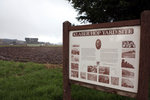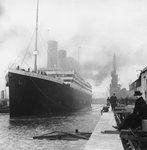

Herman Klaber signed his last will and testament Jan. 11, 1912, and, within a week, left for a three-month business trip to Europe seeking buyers for hops grown in the new Lewis County community of Klaber.
Did the prosperous businessman have a premonition that he might never return to his 22-year-old wife and 2-year-old daughter in Portland? Or perhaps he simply wanted to ensure that his considerable wealth would be distributed as he saw fit.
The 41-year-old millionaire, who wanted to be buried without any ostentation whatsoever, perished when the luxury liner RMS Titanic struck an iceberg on its maiden voyage and plunged into the Atlantic Ocean about 1,000 miles east of Newfoundland, Canada.
It happened almost a century ago — on April 15, 1912.
His body was never recovered.
Although the town he built and named for himself has long since disappeared, Klaber is enshrined in history as one of the 1,517 victims in a historic, deadly maritime disaster.
The Hop King
The California native was born Nov. 18, 1870, to Austrian native George and German-born Bertha Klaber, joining his sister, Sarah, to complete the family. The senior Klaber, who became a U.S. citizen in New York on Oct. 6, 1848, worked in California as a Mokelumne Hill postmaster and later as a coal dealer.
After completing his education, Herman Klaber joined with his cousin, Marcus J. Netter in San Francisco, and Max Wolf as business partners in Klaber, Wolf & Netter, hop dealers. The company had offices in London, San Francisco, Portland and Tacoma.
It specialized in buying and selling the key ingredient in beer manufacturing.
In 1893, Klaber moved north, first to Puyallup and then to Tacoma, where he worked as a hop broker, owned a cigar store and sold insurance.
He also formed Herman Klaber & Co. and shared interest in Klaber Investment Co. with his brother-in-law, H.A. Kaufman, who later was proprietor of the St. Helens Hotel in Chehalis.
As a hops broker, Klaber traveled frequently, including to Lewis County, which became the “Hop Capital of the World.”
In August 1903, The Centralia News-Examiner reported that Klaber & Co. bought 80 acres from C.W. Maynard of Boistfort and began erecting a house, barn and four model hop kilns. In 1906, Klaber bought 40 acres from John Roundtree, and eventually owned 360 acres in the Boistfort Valley, aptly named for the French word meaning “small valley surrounded by green hills.”
He planted 200 acres of hops, creating the Northwest’s largest single hopyard.
But it wasn’t just a hopyard.
A Town With His Name
Klaber invested $75,000 — equivalent to nearly $2 million today — in building a community that he initially considered calling Klaberville, but later settled on Klaber. Six towering chimneys on modern dry kilns spelled out the town’s name — KLABER — with one letter per peak, visible for miles around.
He hired contractors to erect a 920-square-foot building containing a general merchandise store managed by J.O. Wallace, a blacksmith shop, a post office and a meeting hall. They also built a 168-square-foot shop for barber H.L. Morris.
“Mr. Klaber has for many years recognized the attractiveness of Chehalis hops of which he has always been a heavy buyer,” The Bee-Nugget wrote Dec. 21, 1906. “He expects to make the fame of ‘Klaber’s Chehalis Hops’ worldwide in a few years.”
By December 1907, Klaber had persuaded government officials to switch the Boistfort post office to Klaber. His family’s two-story bungalow sat on a knoll overlooking the state’s largest hopyard. He built a 10-room house for his manager, a two-story building for the assistant manager, and five five-room cottages for the help, according to a Dec. 14, 1907, article in The Tacoma News.
He also installed a $3,000 gravity water system with two reservoir tanks holding 75,000 gallons, piping hot and cold water to the homes.
He erected 200 12-by-12-foot shacks in rows facing the hopyard, where 700 to 800 pickers found shelter during the September harvest. Others, including Cowlitz and Chehalis Indians, erected tents on the hillside or near the Chehalis River’s south fork during the month-long harvest. They earned $3 a day, picking hops growing along 12-foot poles and filling boxes 7 feet long, 3 feet wide, and 3 feet deep.
Four 26-foot and eight new 30-foot dry kilns cured baskets of hops, which were baled and stored in warehouses at the farm and near the rail lines. The yard produced 1,500 bales of hops a year, each weighing about 200 pounds, providing 300,000 pounds of hops for European and American breweries.
By then the millionaire businessman had decided to settle down, marrying Sacramento native Gertrude G. Ginsberg on Feb. 13, 1907. They visited California frequently but lived in Tacoma with their newborn daughter, Bernice Janet Klaber, who was born in Portland. They shared a home with Klaber’s 66-year-old mother, Bertha, his widowed brother-in-law, Kaufman, and his two nieces, 9-year-old Elsa Kaufman and 19-year-old Dorothy Danhauser, as well as a live-in servant, 24-year-old Elisa Balsiger.
The family later moved to Portland and spent summers at the Lewis County bungalow on what Klaber referred to as the “ranch.”
This was the life and business Klaber built, one he left behind for what would become one of his last great adventures.